This market continues to float higher—and that means we dividend investors do need to be more selective. But it doesn’t mean there aren’t high-yield options on the table for us.
With that in mind, today we’re going to look at two closed-end funds (CEFs) that hold many of the same stocks, and have similar dividend payouts. But one is a (time-limited) bargain while the other is overpriced and ripe to be sold (despite its 10.1% yield).
A Full Year of Stock-Market Gains—in 8 Months!?
Before we go further, let’s stop and talk about what the S&P 500 is doing right now.
In a typical year, the index will return about 10%. That’s been the case for well over a century. Each calendar year can, of course, be very different. But on average, we’re looking at about 10% per year.
That brings us to today’s conundrum: the S&P 500 is already up a little under 10% in 2025, and we’ve still got four more months till the end of the year! That, by the way, does not mean stocks are likely to trade flat for the rest of the year. Truth is, no one knows what will happen. But there are signs of what the market expects to happen next.
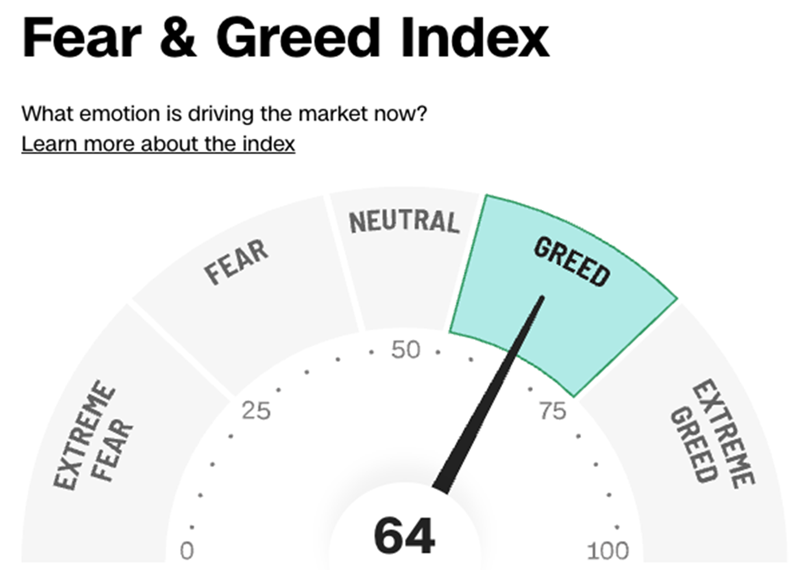
Source: CNN.com
According to CNN’s Fear and Greed Index, a reasonable measure of investors’ mood, we’re in “greed” territory now, down from “extreme greed” in early July. Interestingly, that slight cool-off has come as the recovery has continued. So if there’s further cooling, markets could indeed sell off.
Why hasn’t that already happened? Strong earnings, for one.
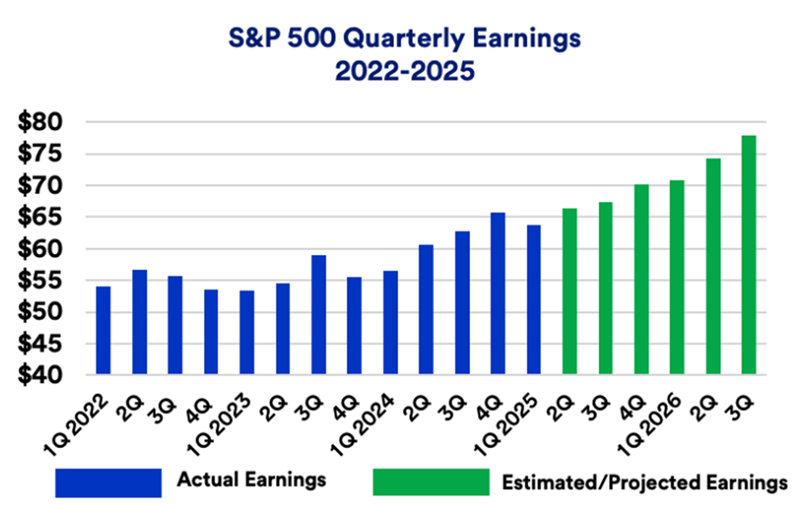
Source: U.S. Bank
Earnings have been steadily rising, partly due to AI-driven productivity gains and partly due to the US economy’s overall resilience. More important, market expectations were falling heading into this earnings season, especially among popular finance publications, many of which were sounding, well, pretty dire.
One of the most extreme was Fortune, which expected 0% earnings growth for 2025. But as of August 8, 81% of companies had beaten their own Q2 estimates, with 11.8% earnings growth across the board.
Of course, that just begs the question: What’s next?
High Valuation Signals Caution
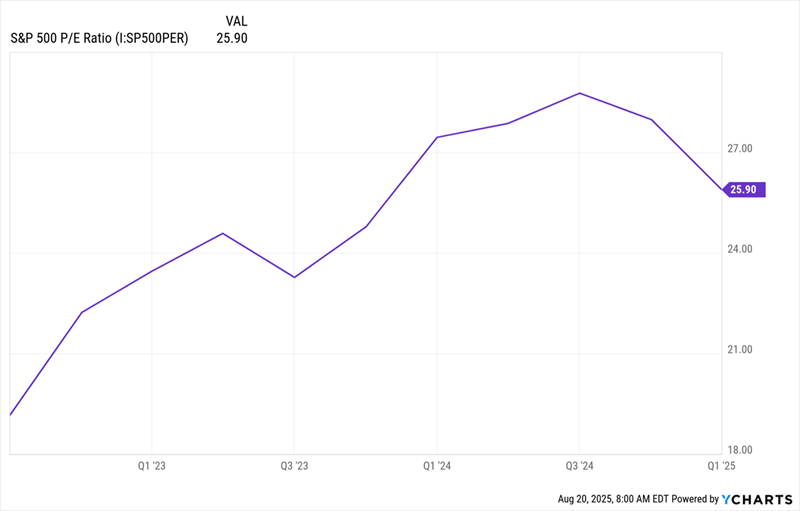
While stocks are performing well and the economy is still growing, this good news is priced into stocks: The S&P 500’s price-to-earnings ratio has soared from below 20 a couple years ago to the current level of 25.9.
That’s high on both a recent and historical basis. Back in the dot-com era, the S&P 500’s P/E soared to 30 before stocks plunged, which is why some investors are starting to worry now.
Before I go further, I should say that the answer here is not to sell. That’s what some of the mainstream press is urging readers to do because, well, they’re in the business of selling fear. But trying to time the market like this almost never works, as the 10%-per-year average return on stocks shows.
And of course, we’d instantly cut off our dividend stream. Not good!
Instead, the key is to avoid overpriced assets and lock in profits where things have gotten too pricey (rebalancing our portfolios, in other words).
The Gab on GAB? Sell Into Its Ridiculous Premium
Take, for instance, a closed-end fund (CEF) called the Gabelli Equity Trust (GAB). It’s a huge yielder, with a 10.1% dividend, and it’s had a strong year, beating the S&P 500 on a market-price basis, with a 17.7% total return as of this writing.
The fund, like the S&P 500, holds large caps like Mastercard (MA), Berkshire Hathaway (BRK.A), Deere & Co. (DE) and Texas Instruments (TXN). But there is a problem here.
GAB’s Market Price Outruns Its Portfolio
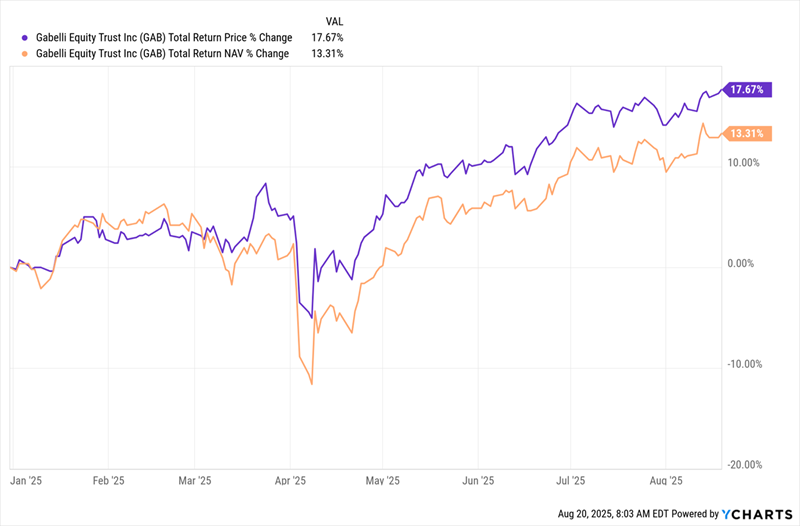
Note how GAB’s total return, based on its market price (in purple) is well ahead of the fund’s total NAV return, or the performance of its underlying portfolio (in orange)?
GAB’s market price is soaring higher than its NAV because investors’ appetite for stocks has grown. This has also meant GAB trades at a 6.6% premium to NAV, even though it was trading at a discount less than a year ago.
GAB’s Discount Vanishes
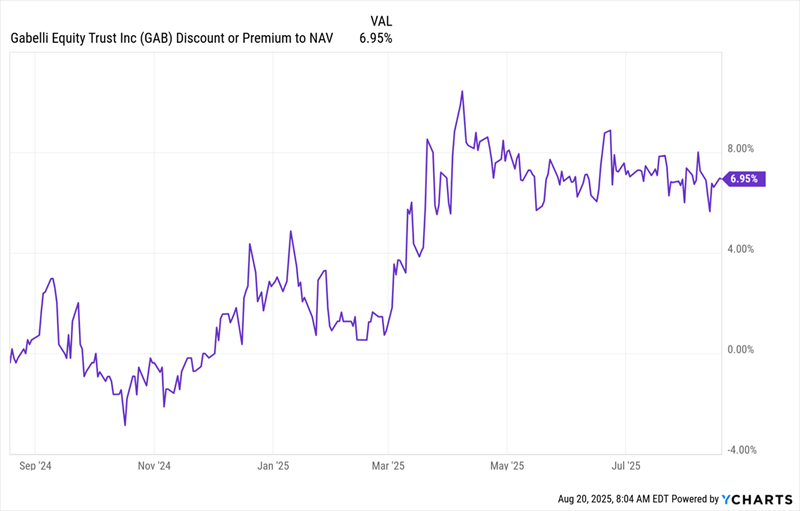
This is a classic profit-taking moment for a CEF investor: When a regularly discounted CEF flips to a premium and sticks there, it’s time to sell. This is very much the case with GAB.
For a cheaper alternative, consider the Adams Diversified Equity Fund (ADX). It has many holdings in common with GAB, so you’re getting similar exposure. As for the dividend, it does float around a bit, as ADX commits to paying 8% of NAV as dividends. But the fund does pay out four times a year, which does add some consistency.
The key point, however, is that ADX is a far better deal than GAB, trading at an 8% discount that’s been fading (in the usual two-steps-forward, one-step-back pattern).
ADX’s Discount Is Wide, But It’s Been Trending Smaller
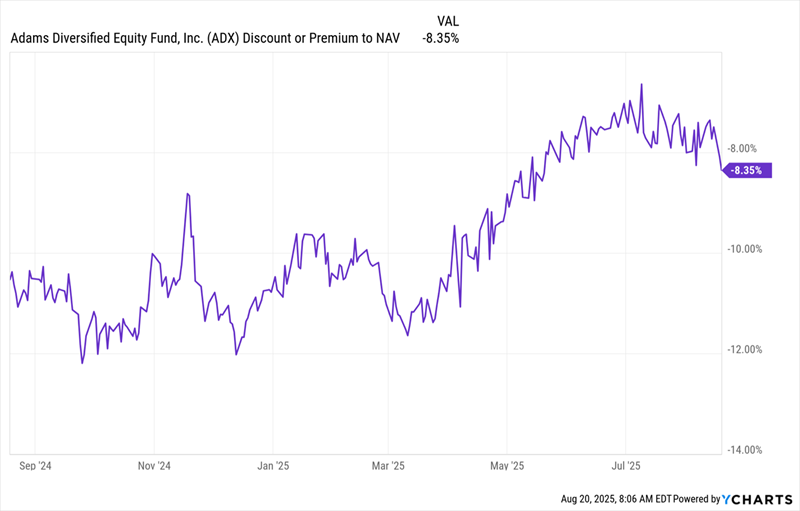
But here’s the real reason to go with ADX over GAB: Even though they hold similar assets, this fund is a far superior performer over the long term.
ADX Crushes GAB
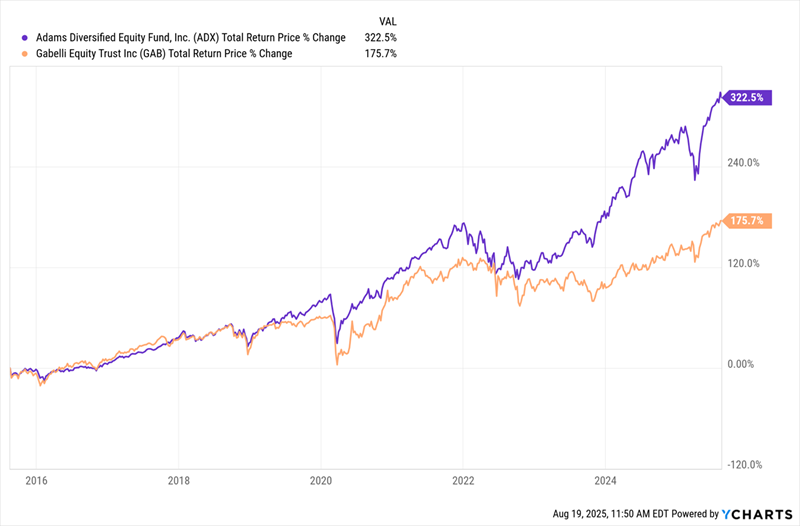
With 323% market-price-based return over the last decade, ADX has trounced GAB’s 176%. The market should reward that with a premium, yet ADX is much cheaper than GAB, trading at a discount while the underperformer trades at a premium!
This is the kind of mispricing we see all the time in CEFs. And patient income investors can take advantage using the age-old approach of buying low and selling high.
That’s another way of describing what we’re doing here: buying discounts and selling premiums. It’s a simple CEF strategy that’s earned investors strong profits and reliable dividends for decades (or in ADX’s case, a century, as it was launched in the 1920s).
Urgent: My Top 4 CEFs Are Still Cheap (and They Pay Huge 9.5% Dividends)
That GAB-versus-ADX comparison is just one example of the many mispricings that exist in the CEF world right now. And they’re just waiting for us to pounce on them!
That’s why CEFs—which pretty well all investors overlook—are a terrific place to invest as stocks look more and more overvalued.
I’ve put together a special Investor Bulletin naming 4 of my top CEFs to buy now. They yield a rich 9.5% on average, and they’re cheap, positioning us for strong upside as their (totally undeserved) discounts vanish.
Click here and to read this urgent Investor Bulletin right now. When you do, I’ll give you a FREE Special Report revealing the names and tickers of all four of these 9.5%-paying funds!
Before you make your next trade, you'll want to hear this.
MarketBeat keeps track of Wall Street's top-rated and best performing research analysts and the stocks they recommend to their clients on a daily basis.
Our team has identified the five stocks that top analysts are quietly whispering to their clients to buy now before the broader market catches on... and none of the big name stocks were on the list.
They believe these five stocks are the five best companies for investors to buy now...
See The Five Stocks Here

We are about to experience the greatest A.I. boom in stock market history...
Thanks to a pivotal economic catalyst, specific tech stocks will skyrocket just like they did during the "dot com" boom in the 1990s.
That’s why, we’ve hand-selected 7 tiny tech disruptor stocks positioned to surge.
- The first pick is a tiny under-the-radar A.I. stock that's trading for just $3.00. This company already has 98 registered patents for cutting-edge voice and sound recognition technology... And has lined up major partnerships with some of the biggest names in the auto, tech, and music industry... plus many more.
- The second pick presents an affordable avenue to bolster EVs and AI development…. Analysts are calling this stock a “buy” right now and predict a high price target of $19.20, substantially more than its current $6 trading price.
- Our final and favorite pick is generating a brand-new kind of AI. It's believed this tech will be bigger than the current well-known leader in this industry… Analysts predict this innovative tech is gearing up to create a tidal wave of new wealth, fueling a $15.7 TRILLION market boom.
Right now, we’re staring down the barrel of a true once-in-a-lifetime moment. As an investment opportunity, this kind of breakthrough doesn't come along every day.
And the window to get in on the ground-floor — maximizing profit potential from this expected market surge — is closing quickly...
Simply enter your email below to get the names and tickers of the 7 small stocks with potential to make investors very, very happy.
Get This Free Report